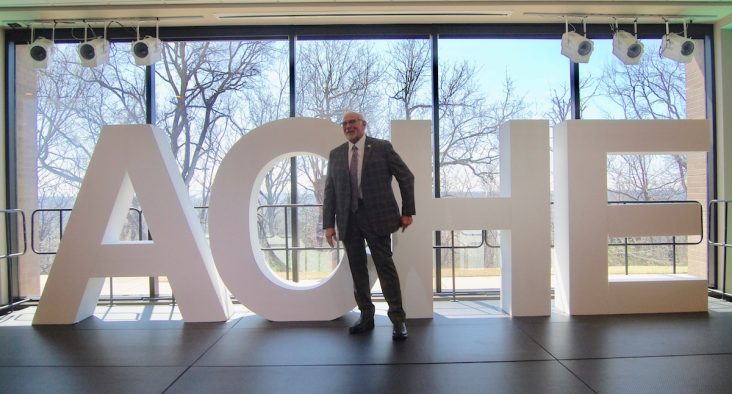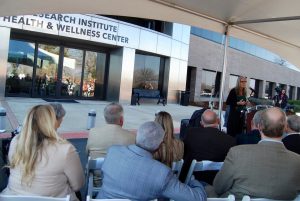ACHE opens first floor of the Research Institute Health and Wellness Center
by March 10, 2023 3:15 pm 1,944 views

Kyle Parker, president and CEO of the Arkansas Colleges of Health Education, poses Friday in the Research Institute’s event center.
Arkansas College of Health Education (ACHE) officially opened its Research Institute Health and Wellness Center Friday (March 10), giving several hundred people who gathered for the official opening a peek at the art, classroom and research center space on the first floor.
A gallery filled with art supplied by the Center for Art on Main in Van Buren, the Regional Art Museum in Fort Smith and Northside High School and Southside High School in Fort Smith served as an introduction to the center’s first floor. The floor is also home to a research lab and classrooms for adult art classes, art exhibitions, culinary experiences, ceramic and pottery studio, kindergarten through 12th-grade art programs, explore artist talks and more.
The center has agreements with art galleries in Hot Springs, Fort Smith, Van Buren and Poteau as well as internationally known and award-winning artists to bring “exceptional” pieces of art to the center to be viewed and purchased, said Kyle Parker, ACHE president and CEO.
ACHE acquired the former Golden Living Headquarters on Fianna Way in 2020 to house a medical research facility and health and wellness education center. In 2021, ACHE received a $32.3 million anonymous donation to support a holistic approach to health and wellness and include partnerships with public schools, art centers and more at the institute. The donation created an endowment that will pay for staff, program costs and construction at the center.
“This health and wellness center is solely dedicated to improving the wellbeing of our community, to the utilization of arts, nutrition and physical exercise,” Parker said. “Our vision for this center will provide a welcoming and supportive environment that caters to the health and wellness needs of individuals of all ages. From our childhood programs to our senior adults, every class and even has been designed with the appropriate age group in mind.”
He said a range of classes would be offered in visual arts, ceramics, and applied arts, which can produce wonderful works but also help those with neurological disorders. Classes are open for booking on the ACHE website, with some classes beginning soon.
“Our physical exercise classes and dance programs have been designed to improve the bodies of all. Our arts programs help reduce stress and create a more balanced, healthy and wellness environment,” Parker said. “It does not matter where you come from or the circumstance in which you live. Everyone can benefit dramatically from this endeavor.”

Dr. Elizabeth McClain, ACHE’s chief wellness officer, said the focus of the center will be to support health and wellness throughout the lifespan from “early childhood through creative aging.” It will also provide opportunities for the community to be creative. On the academic side, the center will be engaged, looking at different aspects of research.
“We are always looking for the best opportunities – the best diet, the best exercise program, the best aspect to improve mental health. Each of those is very complex and based on opportunities we each have throughout life, along with genetics and health issues,” McCain said.
She said that by looking at that and embracing the parallel research, the administrators can develop more programs for the center and for people in the community.
“We all know that art makes us feel better. We all know that eating well leads to feeling better. What does it do when a community engages together, cooks together, and eats together? They may or may not know each other, but they can share the experiences,” McCain said. “Can we prove that some of that helps with feelings of isolation, helps with mental health?”
Because the center’s structure is to build community partnerships rather than just higher art, culinary art, or applied art employees, McCain said ACHE would not have to increase staff greatly for the center. Once the other floors of the center open, however, more employees will be needed.
Work on the five-story facility is ongoing and will include offices and one of the largest medical research facilities in the nation. The facility is also home to the Fort Smith Symphony and, later this year, will house Haas Hall Academy’s Fort Smith campus.
